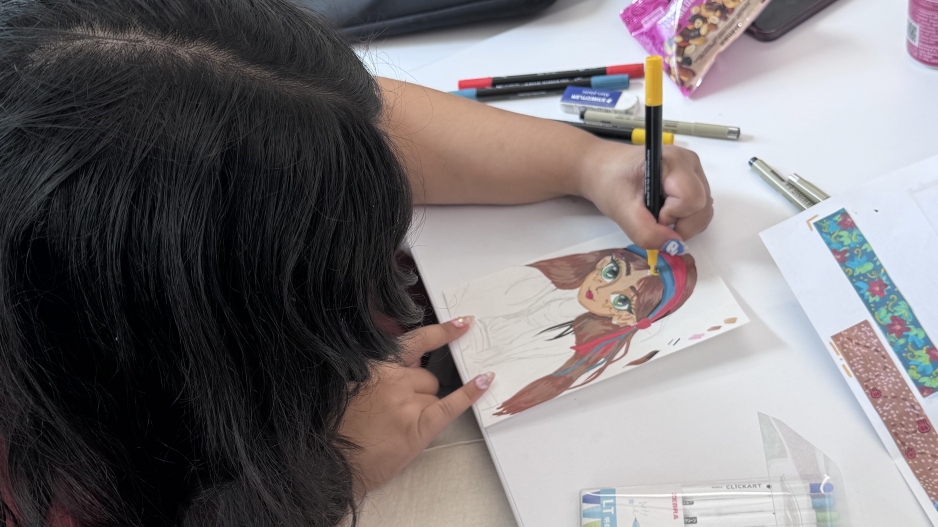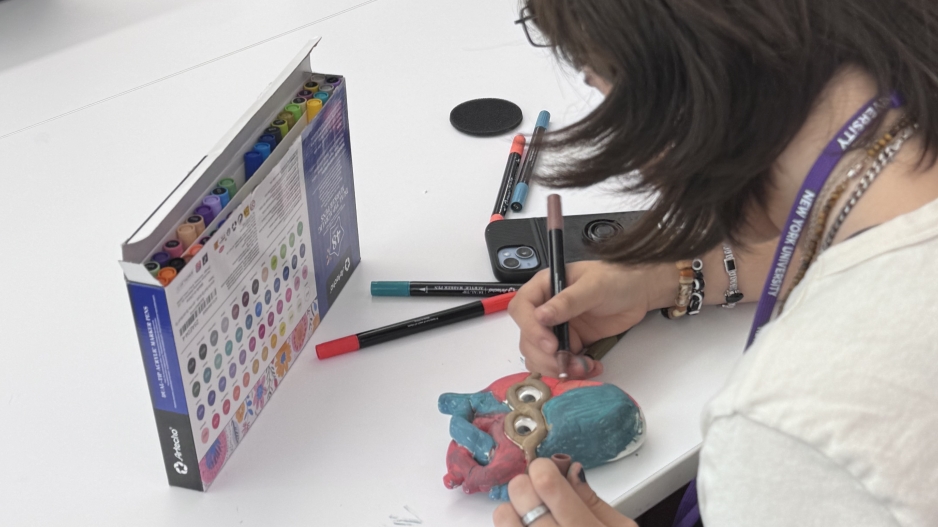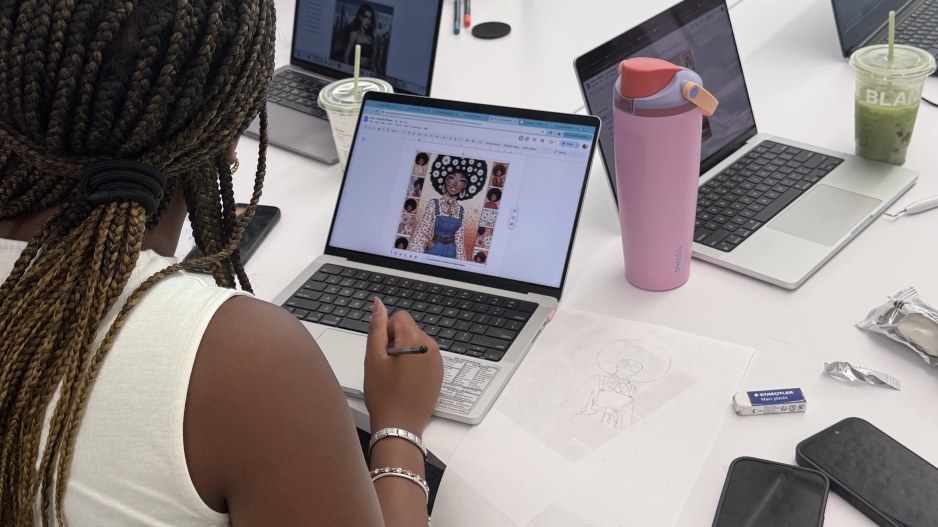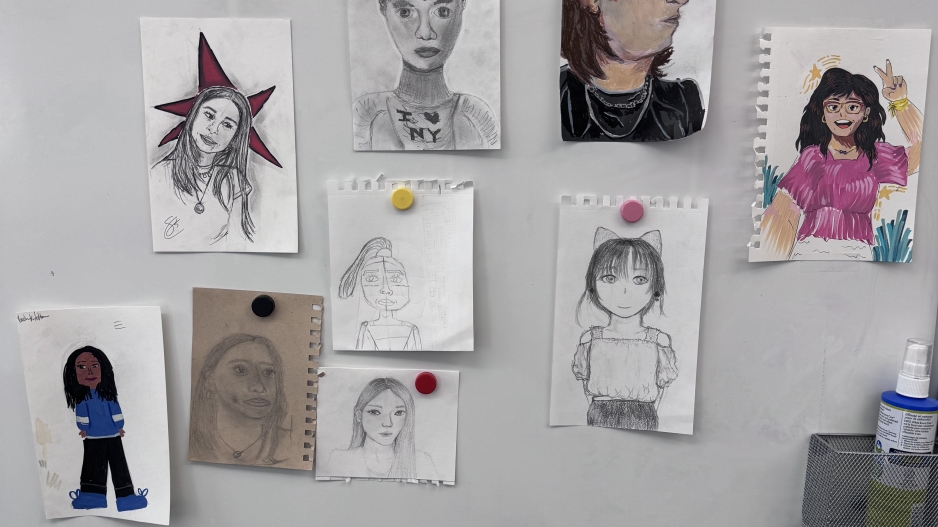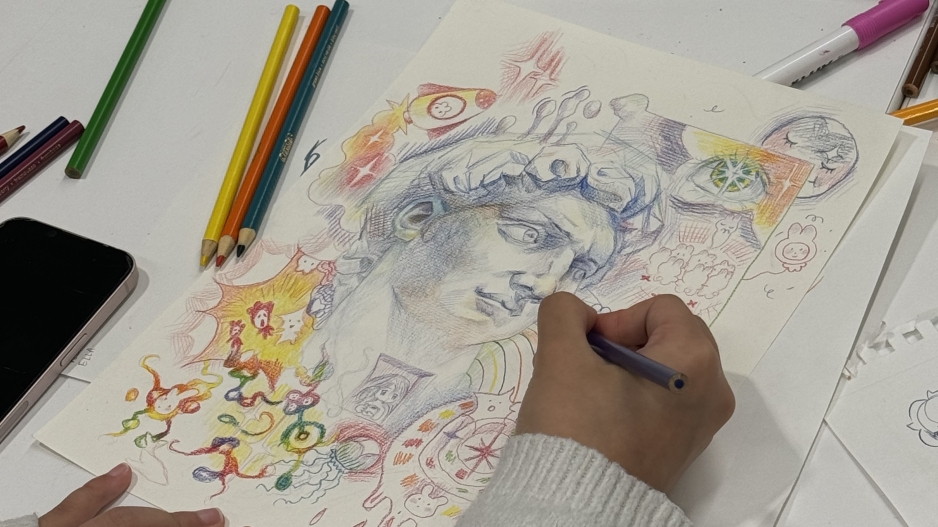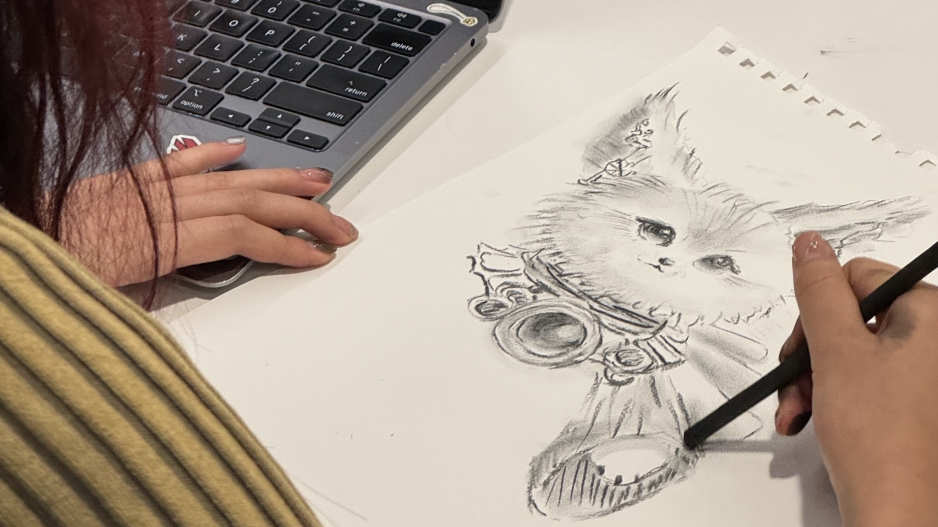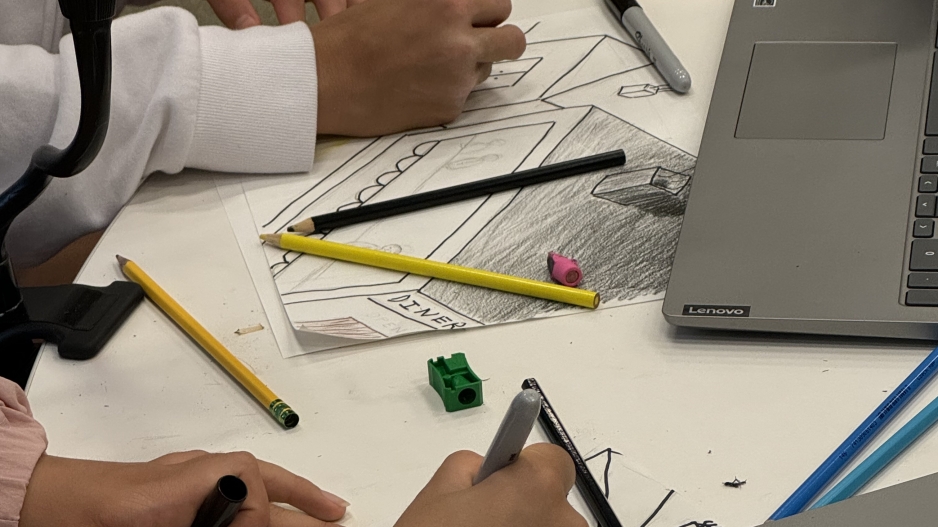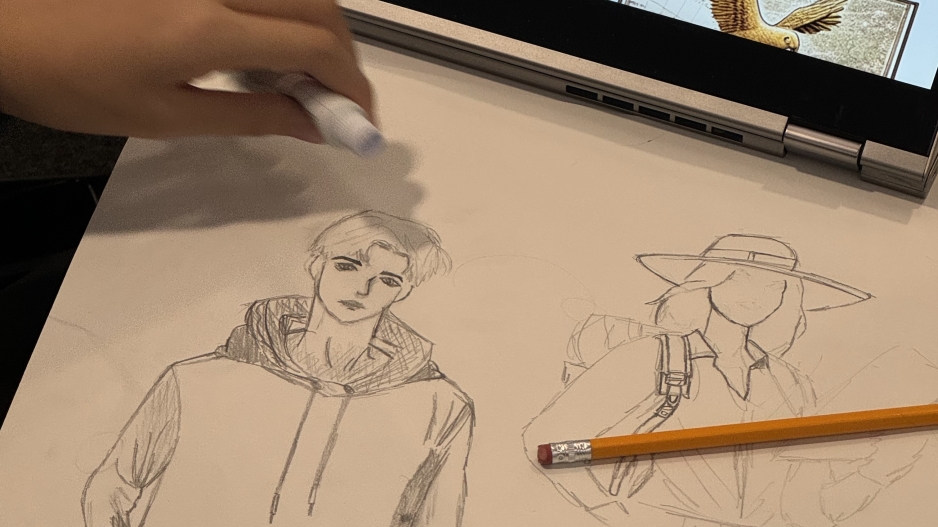Summer 2026 application will open in January 2026.
Please come back to apply.
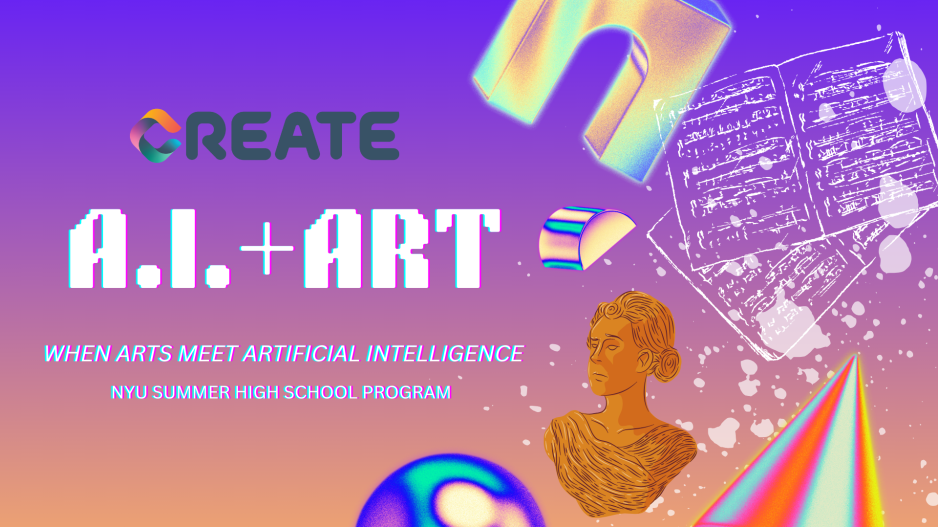
Artificial Intelligence (AI) is becoming increasingly relevant to art learning with applications in art creation, at understanding and ethical implications around creating with AI. AI is also becoming critical in youth’s future careers - including creative careers.
Most AI learning resources are currently geared towards CS and STEM classrooms. In this two-week program, we explore how we can use AI for creative learning. Students will learn about how foundational generative AI models work, how they can be used in creative fields, what their social and ethical implications are, and even create creative robots. This program will consist of hands-on learning activities, where students will use AI tools to support art-making, develop and modify AI algorithms personalized for their art practice, and will discuss the future implications of AI in art. Students will walk out with fundamental creative AI knowledge, experience in using AI tools, and media co-created with AI.
Expand your creativity and explore Arts through Artificial Intelligence.

Age Requirement
Our program is accepting students who will be entering sophomore, junior, or senior year of high school in Fall 2026.
Technical Skills
This program is well-suited for students who are interested in using emerging technology for art-making, and prior experience with artistic practice is preferred.
During the program, you will be asked to participate in Python programming exercises. Experience with Python programming is preferred, although additional help will be available for students new to programming.
Students must be comfortable with using computer devices in class and for assignments at home.
Summer 2026 Program Dates
07/27 - 08/07, 2026 (In Person)
Application Fee
Non-refundable application fee: $50 upon submitting your application
Program Costs
Tuition: $2,845
Other required fees:
- $100 UP Service fee
- $100 summer extracurricular event fee to participate in events
- $100 arts material fee
Optional fees (if applicable):
- Student on-campus housing (reservation required):
- Shared Room Traditional Style (NYU Campus): $376/week/person
- Mandatory Summer Meal Plan for residents: 10 Meal Plan + $30 dining dollars/week: $206/week
- International Student Visa and Insurance
Important note: admitted students are required to make 50% of tuition and fees as a deposit to secure their seat in the program. The deposit is non-refundable due to program's running costs.
Scholarships
The Deadline to Apply for Scholarships is April 30, 2026
The scholarship will fully or partially cover Tuition only. Students still remain responsible for paying other fees.
Eligibility
- Scholarships in Summer are needs-based and are only available to commuter students who are based in New York and are assessed as in financial need after NYU Bursary assessment upon the submission of scholarship application.
- Scholarship application is separate from the program application. Students who are interested and eligible for scholarships must confirm their scholarship interest on their application in order to receive an invitation for the scholarship application, which is separate from the program application.
- International students or students located outside of New York are ineligible for scholarships.
Scholarship Instruction:
Instructions on how to apply for scholarships are automatically emailed to anyone 48 hours after completing and submitting an application. Upon NYU's assessment of the applicant's financial background, applicants will be informed by email about the scholarship decision directly by the program.
Please note that the scholarship decision is official and final when announced.
Housing
IMPORTANT - What's new for Summer 2026:
Due to the renovation of NYU Brooklyn Residence Hall, exclusively for summer 2026, students who decide to live on campus during the program will be placed at NYU Manhattan Residence Hall.
Students will need to commute by New York Subway from the Manhattan campus to the Brooklyn Campus. The commute time is about 15-20 minutes. More details to be released directly to the students.
Age requirement:
Students must be more than 15 years old on the Sunday before checking in at the residence hall.
Housing reservation:
If you would like on-campus housing, please indicate so on your program application. Students will be communicated directly about the deadline and forms to complete the housing reservation.
How to Apply
Please come back in January for Summer 2026 Program.
Week 1 Themes
Exploring AI tools: visual art, music, animation
Fundamentals of Creative Machine Learning
Co-creating art with AI
Generative AI
Fine-tuning AI models
Week 2 Themes
Ethical implications of AI
Policy Design
Final Project
Last Day: Art Show
Class Hours
Classes will be held on Monday to Friday from 10 am to 4 pm.
Day 1
Introduction to AI & Art
Day 2
Exploring Applications of AI in Art: An Introduction
To introduce students to applications of AI in art, students explore digital tools that can they can:
Collaborate with to create art such as visual art, music, animations, and prose.
Explore to discover art datasets used to train AI.
- Interact with to reflect on art history and techniques.
Co-creating art with AI:
Co-writing activity
Exploring art activity
Day 3
Art Activity: Representation of self
Self-portraits:
Students are presented with examples of self-portraits in historical art with discussions about key elements in the portraits. Students reflect on how they would like to represent themselves, write them in text keywords, and create self-portraits using analogue art materials of their choice. Students use their text keywords to also create portraits using AI tools. Students reflect on how machines view parts of their identity, what assumptions are made, how they can interact with machines to represent themselves, and why machines make assumptions about their identities. Students explore training data, algorithmic bias, and artistic representation through generative AI tools.
Exploring bias:
Students use different identities in their prompts to reflect on how AI-generated media changes with different identities in the prompt. They also use the Diffusion Bias Explorer tool to compare images generated from different identity keywords.
Dreaming Futures:
Students create fictional utopian dreams about self and their communities using generative AI tools. They explore prompting techniques to represent their ideas of future dreams. Students share their fictional futures, prompting techniques, and frustrations with AI tools to generate imagery.
Day 4
Introduction to Machine Learning:
Students learn the basics of Machine Learning algorithms, and how Neural Networks work.
Generative AI:
Students explore different AI-generated artwork (images, videos, music, text, animations, 3D models). Students learn about the history of generative computational models through example artworks, how generative AI is different from other types of AI, and real-world creative applications of generated media, such as, in game design, advertisement, graphic design, music, etc.
How do Large Language Models work:
Using simulation activities, students learn about attention models, transformers, large language models, how ChatGPT works (generative pre-training, supervised fine-tuning, reinforcement learning from human feedback). They participate in a game simulating the experience of building a dataset of a character, and training themselves as a model, and using the model to make predictions.
How text-to-image generations work:
Using visualizations and metaphors, students learn about Convolutional Neural Networks, Diffusion models and CLIP. They participate in a game simulating generating drawings based on training data from hypothetical doodle datasets.
Day 5
Fine-tuning AI models
Day 6 (Week 2)
Creating music with AI tools
Character Design with AI:
A character design activity that incorporates AI at different stages, such as using AI for creating references, getting feedback, visual design, and personality design. Supplemented by a guided code notebook, students write character descriptions, create character references, develop character sketches or 3D models, get personalized feedback to refine their artwork, use AI to compare multiple pieces of artwork, create their character's personality, and create an interactive chatbot to have conversations with their character. Students share their final interactive characters and the character design process.
Day 7
The Good, the Bad, the Ugly: Ethical Implications of Using AI in Art
Ethical questions:
Through guided question-asking, instructor leads students through different ethical implications of AI in Art-making. E.g. "How would this music AI potentially benefit or harm artists?" "What if artists' data is used in the system without their consent?" "Would this art filter work for every skin color?" "Did you know that chatGPT can sometimes be incorrect?". This is followed up by students exploring real-world case studies from harms caused by AI, e.g. the Artists vs Stable Diffusion lawsuit, and voice their opinions on the long-term impact that AI can have on artists, and society.
Attribution vote:
Students are given 10 hypothetical dollars and different stakeholders in the AI and Art ecosystem. During the sale of an AI-generated artwork, students vote on who should make what percentage of profit. Students explain their rationale behind their vote.
Poster design:
Students choose one of three topics: (1) Benefits of AI for Artists. (2) Harms of AI for Artists. (3) Designing AI that would Minimize Harms and Maximize Benefits for Artists.
Policy Design:
Students will ideative and develop policy regulations around the use of AI in art practices, creative corporations, and art learning environments. Students will discuss and debate the implications of these policies on different stakeholders in the AI art ecosystem.
Day 8
Final Project: Project scope, art concepts, initial prototypes
Day 9
Final Project: Final prototypes, In-class critique and refinement
Day 10
Art Show: Set up and Final Show
Student Work Showcase
Frequently Asked Questions:
-
A: Admission decisions are released on a rolling basis and typically twice a month, at the middle and end of each month. You will receive an email from NYU once the admission decision is released. If you are admitted to the program, congratulations and you need to confirm your enrollment within 7 days after receiving the offer letter.
-
Once you submit your application, it usually takes 1-2 weeks to receive an admission decision. The decision will be communicated by email, so make sure you closely monitor the email and take the required actions.
If you decide to accept the offer and matriculate to the program, there's a 50% program fee as a deposit. The deposit amount will be deducted from the final bill which NYU Bursar will issue once you get closer to the program start day. Please note that the deposit is to secure your seat in the program and is non-refundable.
-
A: On-campus housing is administered by NYU Housing for an additional fee (not included in the price of tuition). All admitted participants who indicate interest in housing in the application will receive an email with information on housing fees and how to apply.
-
A: Need-based scholarships are available for qualified students who are based in New York. If interested in a scholarship, please indicate so on your program application. Within 48 hours of submitting your application for program admission, you will receive instructions on how to submit a separate scholarship application. All scholarship applications must be received by the indicated deadline. Please submit your program application prior to the deadline to ensure you have enough time to receive and complete the separate scholarship application.
-
A: International students are eligible to apply for the program. They might need a Visa for entry. NYU Office of Global Services (OGS) is the resource hub and provides the necessary documentation to admitted students with Visa applications.
-
A: Students who have accepted their admission to the program will not be able to view and pay their bills immediately after their enrollment. Students will be asked to make a 50% program deposit to secure their participation. This deposit will be counted towards the full program cost.
The complete billing details are released about one month before the program starts.
-
New York City is one of the world's most vibrant, culturally rich cities, and residents of NYU's residence halls are at the center of the excitement. Whether you're living in one of the residence halls centered around Washington Square in Greenwich Village, in Brooklyn Heights, or in a residence hall located in one of the city's other bustling neighborhoods, there is an endless amount of activity.
Students will be placed at one of the Residence Halls. You can find details of all residence halls on this page. More details will be provided directly to the resident students before the program.
-
Yes, you will need to bring your own laptop (and its charger) for class every day.
-
You need to ensure that your computer supports saving files, has a web browser, and can connect to the internet. You also need to ensure that your computer has a Python 3.0 or later installed on it. There are no further software requirements for this program. If you use any digital creation platforms in your art practice, such as Adobe Creative Cloud, or GarageBand, then please have them installed - however, this is not required.
-
Carry your preferred art making tools (e.g. pencils, markers, paints, musical instruments, etc.) if you would like to integrate AI into your existing art practices. However, this is not required, and we will have plenty of art materials available in the classroom.
Contact Us
CREATE Lab
This website includes the most updated information.
If you have any further about the academic content about program, contact CREATE Lab create.AIArt@nyu.edu
Admission and Enrollment
Most of the information should have been shared by email.
If you have technical issues with the application portal, or your admission/enrollment, contact University Program university.programs@nyu.edu with your name, NYU Net ID, Program Name (AI+Art High School Program), and session dates.
Location
The in-person sessions will be hosted in NYU Downtown Brooklyn. CREATE Lab, 370 Jay St, Brooklyn, NY 11201
Google Map


